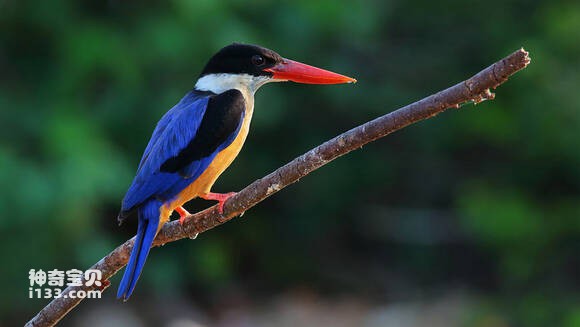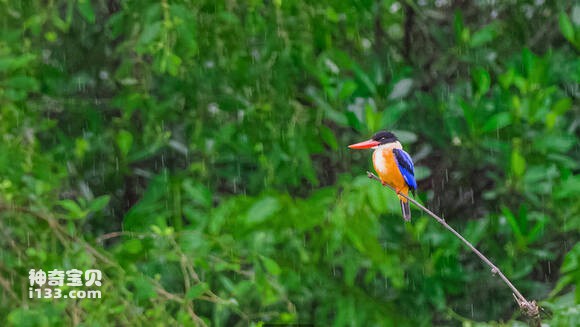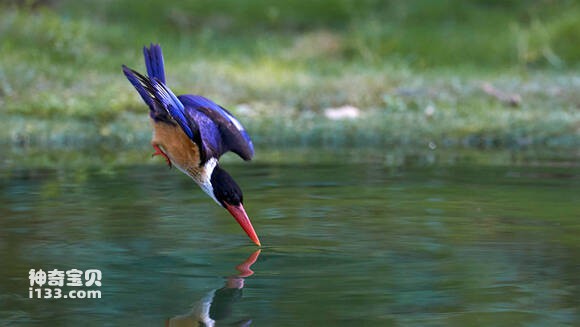Halcyon pileata
IUCN
LCBasic Information
Scientific classification
- name:Halcyon pileata
- Scientific Name:Halcyon pileata,Black-capped Kingfisher
- Outline:Climbing birds
- Family:
Vital signs
- length:25-31cm
- Weight:64-115g
- lifetime:About 10 years
Feature
The head is characterized by black, the wings are covered with black feathers, and the rest of the upper body is bright and luxurious blue-purple
Distribution and Habitat
It is distributed in Bangladesh, Brunei Darussalam, Cambodia, China, India, Japan, Democratic People's Republic of Korea, Republic of Korea, Lao People's Democratic Republic, Malaysia, Myanmar, Philippines, Singapore, Thailand and Viet Nam.
Travellers: Indonesia, Nepal, Pakistan, Sri Lanka, Taiwan Province of China.
China is distributed in Heilongjiang, Changbai Mountain of Jilin, eastern, central and southern Liaoning, Hebei, Shandong, Shanxi, west to Gansu, Sichuan, Guizhou, Yunnan, south to Guangdong, Guangxi, Fujian, Hong Kong, Hainan Island and Taiwan. It breeds in large parts of eastern, central and southern China from Liaoning to Gansu, as well as large areas in the southeast, and some areas are resident birds. In Taiwan for lost birds.
The blue jade is mainly found in forest streams and rivers, ponds and swamps at the foot of mountains and plains. It is not unusual to be on the edge of a clear river below 600 meters above sea level. Northern populations migra
Appearance
The forehead, head, side and occipital of the blue jade are black, and the back neck is white, extending to both sides and connecting with the throat and chest white, forming a wide white collar ring. There is a white spot under the eye. The back, waist and tail are covered with cobalt blue feathers, the tail is also cobalt blue, and the shaft is black. The overlying feathers are black, forming a large black spot. The primary feathers are dark brown with blue fringes, white on the lateral base, and a large white spot on the medial base, corresponding to a lilac blue spot on the lateral. The secondary feathers are dark brown on the inside and cobalt blue on the outside. Chin, throat, side neck, buccal and upper thorax white, below the thorax including the axilla and underwing coverts orange brown.
Juveniles have brown collar on the nape of the neck, a light brown end margin on the throat and breast, and sometimes a black margin on the ventral side.
The iris is dark brown. Mouth co
Details
Halcyon pileata, Black-capped Kingfisher, no subspecies。

The blue jade is often alone, generally resting on the stumps and rocks of the river, and sometimes on the low branches of small trees near the river. Often for a long time motionless staring at the water, as soon as the fish and shrimp in the water, immediately with a very rapid and fierce posture into the water with the mouth to catch. Sometimes the wings are suspended in the air, looking down at the water, and the food immediately plunges into the water and is quickly captured. The prey is usually brought back to the habitat, beaten on a tree branch or stone, and eaten whole after the fish is dead. Sometimes they also fly in a straight line at a low altitude over the water, flying very fast, often screaming while flying.
The ecological habits of the blue jade are similar to those of other species in the family. It mainly feeds on aquatic animals such as small fish, shrimp, crabs and aquatic insects. Frogs and coleoptera, lepidoptera and larvae are also eaten.

The breeding season occurs from May to July. The nest is built on the earth cliff or on the embankment of the river, and the tunnel is dug with the mouth for the nest. The two sides dig the tunnel together, which can reach a depth of 60 centimeters, and the end expands into the nest, the size and diameter of 10-15 centimeters. These caves are generally bare of bedding. The eggs are laid directly on the nest ground. Once the nest is complete, the female lays four or five pure white eggs. Each clutch lays 4-6 eggs. The size is 26-29 x 21-24 mm, with an average of 27.3 x 2.5 mm. Male and female ferries hatch. Young birds are late sex. They are blind when they are born. Incubation period is 19-21 days. After hatching, the parent birds can leave the nest and fly for 23-30 days.

Listed on the IUCN Red List of Threatened Species ver 3.1:2022 - Vulnerable (VU).
It was listed in the List of Land Wild Animals under State Protection that are beneficial or have important economic and scientific research value (Item 270) issued by the State Forestry Administration of China on August 1, 2000.
Protect wild animals and eliminate wild meat.
Maintaining ecological balance is everyone's responsibility!








